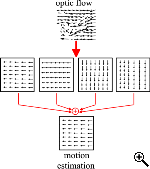|

|
Multiple-model motion estimation in a road scene
taken by a rear-view mirror of a moving car under an overtaking
situations. The model-based decompositions are evidenced
for the same image patch for two different frames
at time k1 and k2. For each optic flow patch the generalized
deformation components are adapted to the input measures and the motion
is estimated from the actual generalized deformation components
weigthed by the corresponding probability values.
|
March 20, 2007 — Reliable complex (e.g. multiple or non rigid) motion analysis
is a challenging problem in computer vision.
A popular class of local flow descriptors
is based on parameterized models of optic flow.
Such models, learned from examples, or specified
a priori as constant and affine (linear) models, are characterized
by a small number of parameters, which provide a
concise description of the optic flow structure that can be
used to recognize motion patterns from image sequences.
A set of adjustable linear models can be used for the analysis of complex dense
optic flow fields. These models are specified as discrete
space-time dynamical systems, in the velocity space, that
are characterized by an unforced or “free” response, given
by the structure of network interconnections, and a forced
response related to the contingent local optic flow information
in input. In this way, given a motion information
represented by an optic flow field extracted by a “classical”
algorithm, it is possible to recognize if a group of velocity vectors
relates to a specific motion pattern, on the basis of their spatial
relationships in a local neighborhood. More precisely,
the analysis/detection occurs through a spatial recurrent filter
that checks the consistency between the spatial structural
properties of the input flow field pattern and a set of
linear models representing (first-order) elementary components
of the optic flow. In order to design a filter that
checks this consistency, in an adaptive way, the linear models
can be considered the process equations of a multiple
model Kalman Filter. Motion segments emerge from
the noisy flows as the output of the Kalman Filter that compares its
prediction to the actual observations of the local properties
of the optic flow.
Manuela Chessa
Silvio P. Sabatini
Fabio Solari
Giacomo M. Bisio
Dept. of Biophysical and Electronic Engineering
University of Genoa
|

